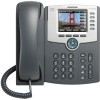Cisco SPA525G2 Brochure - Page 3
Data Sheet, Feature requires support by SIP/SPCP client management server. - headset
 |
View all Cisco SPA525G2 manuals
Add to My Manuals
Save this manual to your list of manuals |
Page 3 highlights
Data Sheet Feature indicator Benefit voicemail has been processed by the user Graphical display Color 3.2-in. QVGA (320 x 240 pixels) backlit LCD graphical display 5-way navigational buttons Navigating menus and multimedia applications 4 soft-key buttons Dynamically present calling options to the user Network features Cisco Discovery Protocol, IEEE 802.1p/Q Wi-Fi 802.11b/g, Wi-Fi Multimedia (WMM) (802.11e) Wi-Fi security ● Wired Equivalent Privacy (WEP), 64 or 128 bit ● Wi-Fi Protected Access (WPA), Personal and Enterprise ● WPA2, Personal and Enterprise ● Wi-Fi Protected Setup (WPS) Ethernet switch 10/100 PC switch port enables LAN connectivity to a co-located PC. Can designate separate VLANs (802.1Q) for the PC and Cisco IP phones, providing improved security and reliability of voice and data traffic. 802.3af PoE WAN port; disabled when phone is used in Wi-Fi mode Volume control Volume-control toggle provides easy decibel-level adjustments of the handset, monitor speaker, and ringer Applications ● Customizable screen saver on phone display (Photo Album) ● Music player (MP3) ● RSS web services ● Cisco MonitorView ● SIP third-party call control for server-based applications ● Lightweight Directory Access Protocol (LDAP) and Cisco XML-based corporate directory support ● Cisco XML services interface (XSI) Call control and audio features ● Call hold ● Music on hold1 ● Call waiting ● Caller ID name and number and outbound caller ID blocking ● Caller ID mapping for incoming calls ● Outbound caller ID blocking ● Call transfer - attended or blind ● Call conferencing - hosted (N-party) or local (3-party) ● Call forwarding - unconditional, no answer, on busy ● Visual voice message waiting indicator (VMWI) ● Shared/bridge line appearance1 ● Call pickup - selective and group1 ● Call park and unpark1 ● Call back on busy ● Call blocking - anonymous and selective ● Do not disturb ● Intercom1 ● Group paging1 ● Extension mobility1 ● Configurable dial/numbering plan support with inter-digit timers - per line ● URL (IP) dialing support ● Distinctive ringing based on calling and called number ● Supplementary services feature activation codes ● Supplementary services announcements codes ● Configurable supplementary services soft keys ● Individual volume setting per audio path (headset/handset/speaker) Signaling protocol support ● SPCP ● SIP version 2 (RFC 3261, RFC 2543, RFC 3263, RFC 3264, RFC 3275) Voice features ● SIP proxy redundancy - dynamic via DNS SRV, A records ● Re-registration with primary SIP proxy server ● SIP support in Network Address Translation (NAT) networks, including simple traversal of User Datagram Protocol (UDP) through NAT (serial tunnel [STUN]) ● Codec name assignment 1 Feature requires support by SIP/SPCP client management server. © 2010 Cisco and/or its affiliates. All rights reserved. This document is Cisco Public Information. Page 3 of 6









